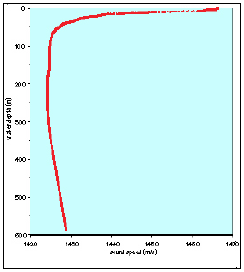Cruise Report: R/V Surf Surveyor Cruise S1-00-CL, Mapping the Bathymetry of Crater Lake, Oregon, 2000
Refraction Issues
The single biggest limitation on the quality of sounding data is water-column refraction. Refraction-related anomalies grow non-linearly with beam angle and the resulting artifacts can create short-wavelength topographic features that may be misinterpreted as lake bed geology. There was some concern prior to the cruise that suspected strong water stratification would present a problem for the beam steering and ray tracing of individual beams. Although a strong thermocline was measured, repeated CTD casts allowed us to correct for refraction effects. A representative water-velocity profile is shown in Figure 10. In fact, no additional empirical refraction corrections were necessary during processing. If all of the alignments were correctly determined, Kongsberg Simrad states that the depth resolution of the EM1002 is 30 cm or 0.1% of water depth, whichever is larger.
 |
| Figure 10 Profile of measured sound speed in Crater Lake for July 29, 2000. |
***previous*** — ***next***

